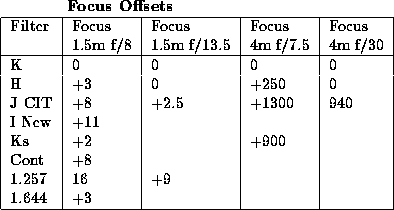
When mounted on the telescope in its nominal position (DCU toward the north) north is down and east is toward the left. We found the pixels to be aligned east-west to better than 0.1 degree on the 1.5-m telescope. On the 4-m in its standard mounting configuration (DCU toward the west) we found north to the left and east to be up on the screen.
Given the different thickness of the various filters in CIRIM (as well as some wavelength dependence of focus), it is necessary to refocus when you change filters. The following table gives the filter offsets for some broad band filters on the 1.5-m and 4m telescopes. These offsets were measured on several nights and are thus accurate to a couple of focus units, but it is good practice to verify the offsets for the filters you are using. Also, given that our telescopes are steel and tend to change size with temperature it is best to monitor the focus throughout the night.

The plate scales also vary slightly with wavelength which will be important for surface photometry programs. On the 1.5m at f/8, I measured relative plate scales of H/K=1.001, J/K=1.013 and I/K=1.013. Similar factors seem to apply at f/13 as well. If exact plate scales are important to your project it is probably best if you measure them in each filter you use.
CIRIM appears to be very mechanically stable. Thus, the flexure of the optics and the Lyot stop are minimal. This results in very stable flat fields. We found peak to peak changes in the flat-field of less the 0.5% over a range of 4 hours in HA. The optical design and good AR coatings used in CIRIM seem to make it rather immune to ghosting, as compared to many other cameras with refractive optics.
We have conducted tests at the 1.5m using the f/8 secondary on the
quality of flat-fielding and the reproducibility of photometry.
Sky flats and dome flats reproduce at about the 2% level and the
differences are dominated by a large scale gradient.
From 35 observations of a single star moved over
the surface of the array at K we found the photometry
reproduced with an RMS of 2% using either dome or sky flats. In particular,
most of the points have an RMS of 1% with a few outliers. We also
noted that measurements taken at nearly the same position on the
array reproduced with the same RMS (1-2%).
This suggests that the large scale sensitivity variations within the array
after flat-fielding, with either dome or sky flats, are not
the major source of variation in photometry.
Rather, the performance is limited
by very small scale sensitivity variations. With the large
pixels (1.2 ![]() ) at the 1.5m this 1% limit could in part be due to the
less than 100% fill factor of the array coupled with the undersampling of
the images This is confirmed to a large part by the RMS of observations
taken at the 1.5m at f/30 with 0.3
) at the 1.5m this 1% limit could in part be due to the
less than 100% fill factor of the array coupled with the undersampling of
the images This is confirmed to a large part by the RMS of observations
taken at the 1.5m at f/30 with 0.3 ![]() pixels.
These showed an RMS of 0.006 magnitudes when flattened with dome flats.
pixels.
These showed an RMS of 0.006 magnitudes when flattened with dome flats.